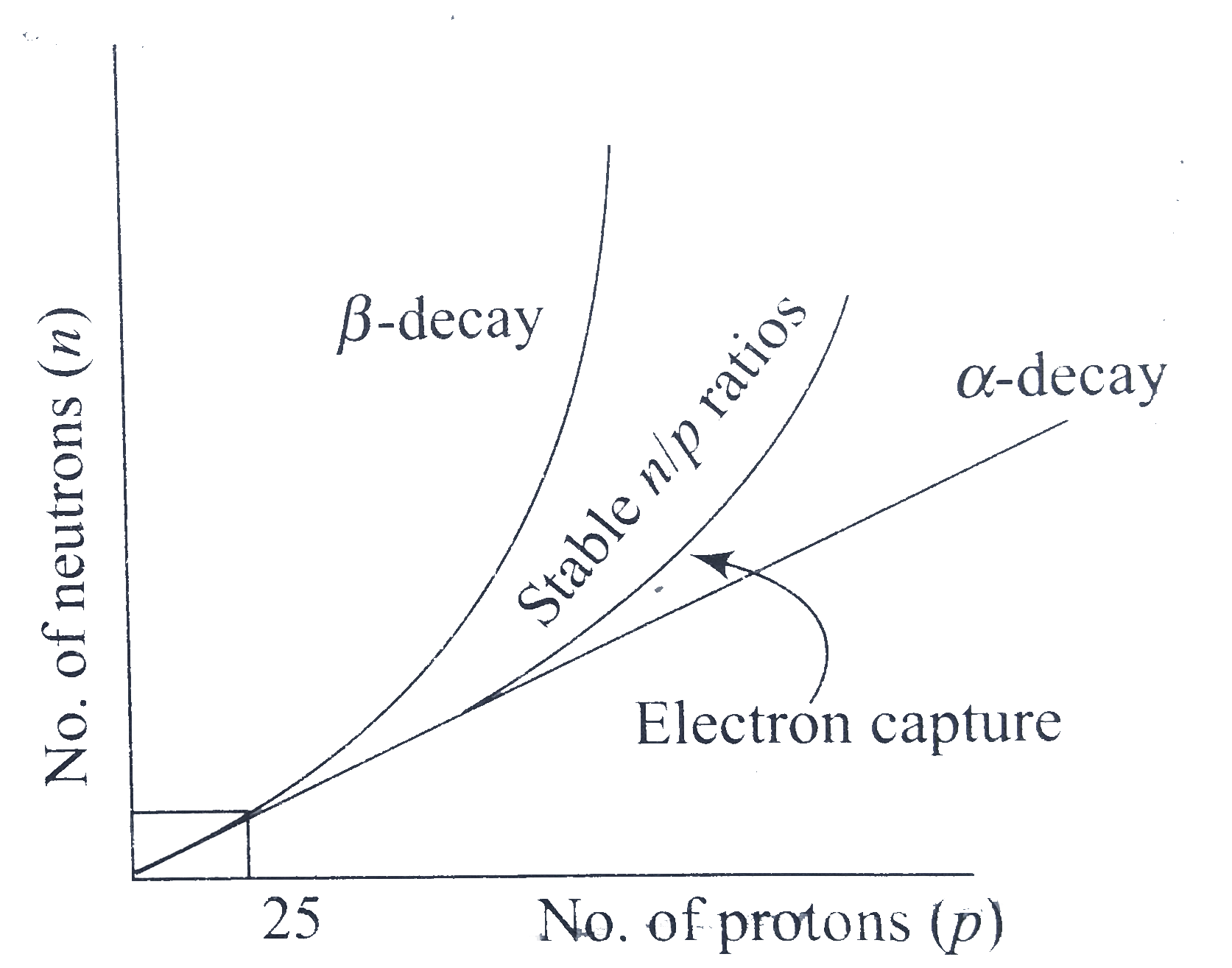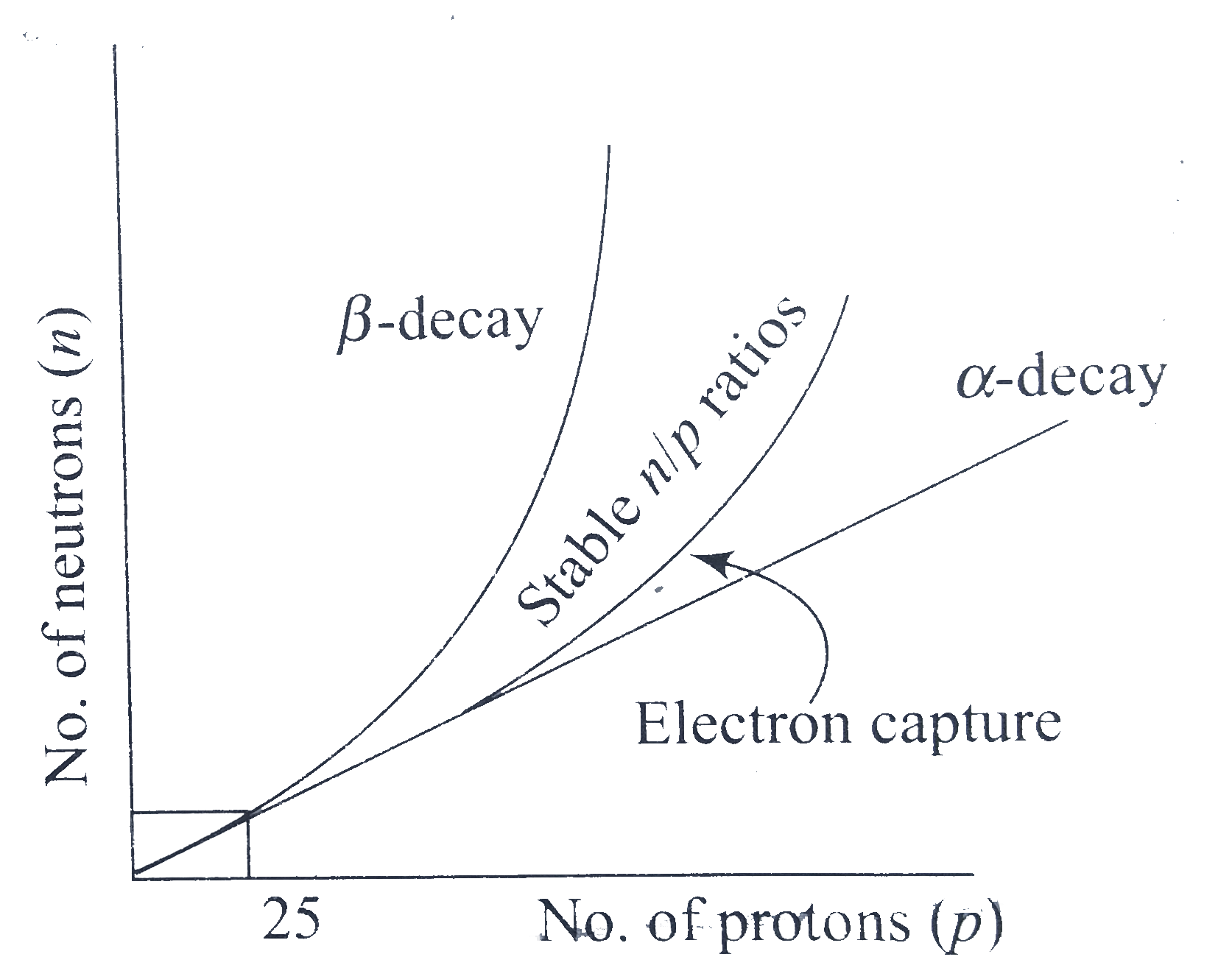Various rules of thumb have seen proposed by the scientific community to expalin the mode of radioactive decay by various radioisotopes. One of the major rules is called the ratio. If all the known isotopes of the elemnts are plotted on a graph of number of neutrons (n) versus number of protons (p), it is observed that all isotopes lying outside of a ''stable'' ratio region are radioactive as shown f The graph exhibits straight line behaviour with unit slope up to . Above , tgose isotopes with ratios lying above the stable region usually undergo beta decay. Very heavy isotopes are unstable because of their relativley large nuclei and they undergo alpha decay. Gamma ray emission does not involve the release of a particle. It represnts a change in an atom from a higher energy level to a lower energy level.

undergoes a series of radioactive decay processes resulting in being the final product. What was the sequence of the processes that occured?
The correct Answer is:b
Since the sum of the atomic numbers and mass numbers on either side of the equation must be equal (matter cannot be created or destroyed),we get
and
Solving, we get
and
The order of the reactions is irrelevant (i.e., ,...) Since gamma rays have no atomic number or mass number, the value of z does not affect this particular calculation.
Topper's Solved these Questions
- NUCLEAR PHYSICSBOOK - CENGAGE PHYSICS ENGLISHCHAPTER - NUCLEAR PHYSICSEXERCISE - Integer
6 Videos
- NUCLEAR PHYSICSBOOK - CENGAGE PHYSICS ENGLISHCHAPTER - NUCLEAR PHYSICSEXERCISE - Fill In The Blanks
5 Videos
- NUCLEAR PHYSICSBOOK - CENGAGE PHYSICS ENGLISHCHAPTER - NUCLEAR PHYSICSEXERCISE - Single Correct Option
182 Videos
- MISCELLANEOUS VOLUME 5BOOK - CENGAGE PHYSICS ENGLISHCHAPTER - MISCELLANEOUS VOLUME 5EXERCISE - Integer
12 Videos
- PHOTOELECTRIC EFFECTBOOK - CENGAGE PHYSICS ENGLISHCHAPTER - PHOTOELECTRIC EFFECTEXERCISE - Integer Type
4 Videos
Similar Questions
Various rules of thumb have seen proposed by the scientific community to expalin the mode of radioactive decay by various radioisotopes. One of the major rules is called the n/p ratio. If all the known isotopes of the elemnts are plotted on a graph of number of neutrons (n) versus number of protons (p), it is observed that all isotopes lying outside of a ''stable'' n/p ratio region are radioactive as shown fig. The graph exhibits straight line behaviour with unit slope up to p=25. Above p=25, tgose isotopes with n/p ratios lying above the stable region usually undergo beta decay. Very heavy isotopes (p>83) are unstable because of their relativley large nuclei and they undergo alpha decay. Gamma ray emission does not involve the release of a particle. It represnts a change in an atom from a higher energy level to a lower energy level.

How would the radioisotope of magnesium with atomic mass 27 undergo radioactive decay?.
View SolutionVarious rules of thumb have seen proposed by the scientific community to expalin the mode of radioactive decay by various radioisotopes. One of the major rules is called the n/p ratio. If all the known isotopes of the elemnts are plotted on a graph of number of neutrons (n) versus number of protons (p), it is observed that all isotopes lying outside of a ''stable'' n/p ratio region are radioactive as shown fig.5.28. The graph exhibits straight line behaviour with unit slope up to p=25. Above p=25, tgose isotopes with n/p ratios lying above the stable region usually undergo beta decay. Very heavy isotopes (p>83) are unstable because of their relativley large nuclei and they undergo alpha decay. Gamma ray emission does not involve the release of a particle. It represnts a change in an atom from a higher energy level to a lower energy level.

Which of the following represents the relative penetrating power of the three types of radioactive emission in decreasing order?
View Solution
Knowledge Check
A radioactive decay can form an isotope of the original nucleus with the emission of particles
Aone α and four βBone α and two βCone α and one βDfour α and one βThe number of neutrons in the radioactive isotope of hydrogen is
A2B0C1D3Assertion : All the isotopes of a given element show same chemical behaviour.
Reason : Isotopes have different number of neutrons present in the nucleus.AIf both assertion and reason are true and reason is the correct explanation of assertion.BIf both assertion and reason are true but reason is not the correct explanation of assertion.CIf assertion is true but reason is false.DIf both assertion and reason are false.
In β− decay n/p ratio:
View SolutionDefine radioactivity. Name various radioactive elements.
View SolutionThe possible sum of the number of neutrons and protons in the isotope of hydrogen is :
View SolutionDeduce the expression, N=N−λt0 for the law of radioactive decay.
View SolutionThe sum of the number of neutrons and protons in the isotopes of hydrogen is :
View Solution
